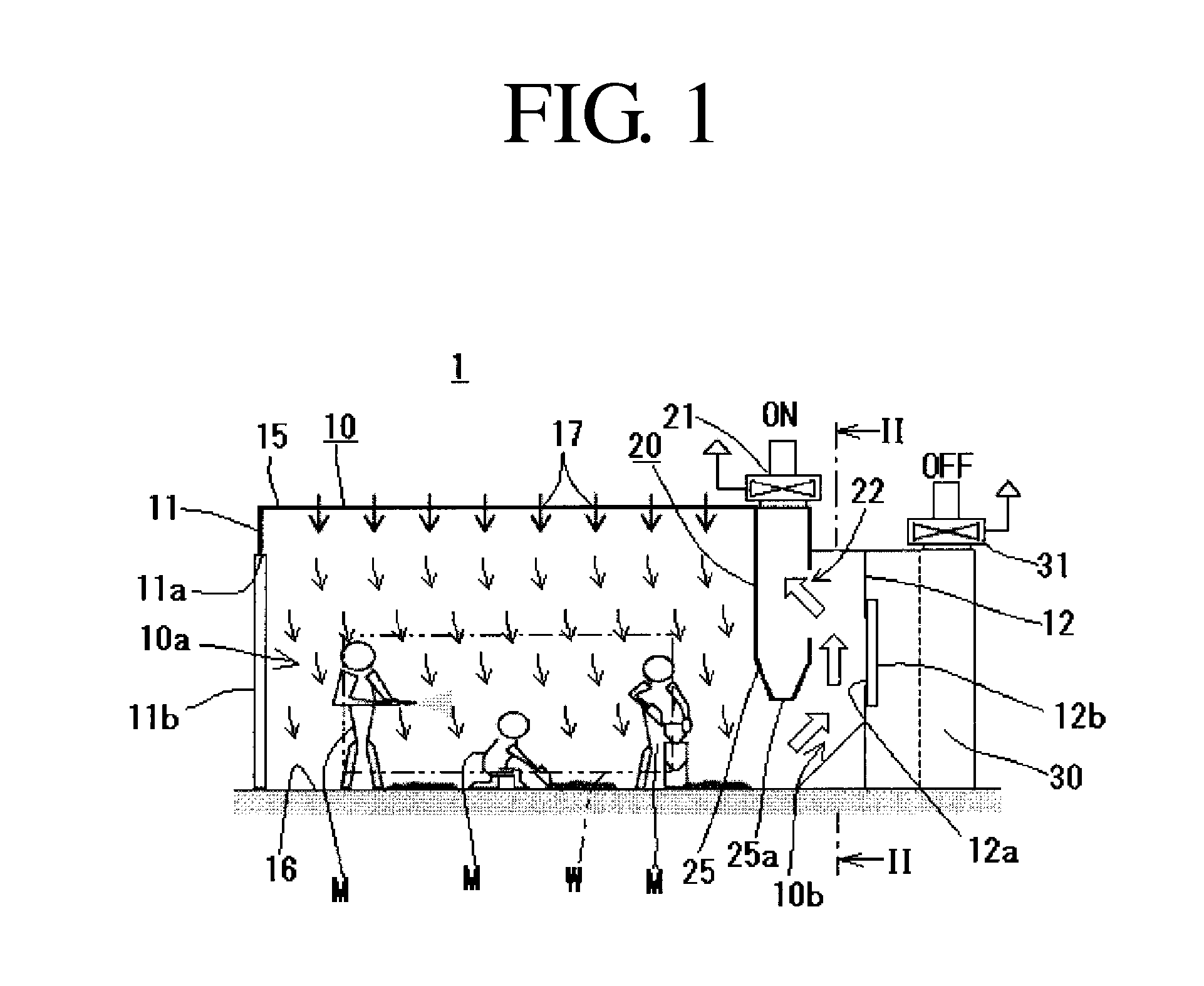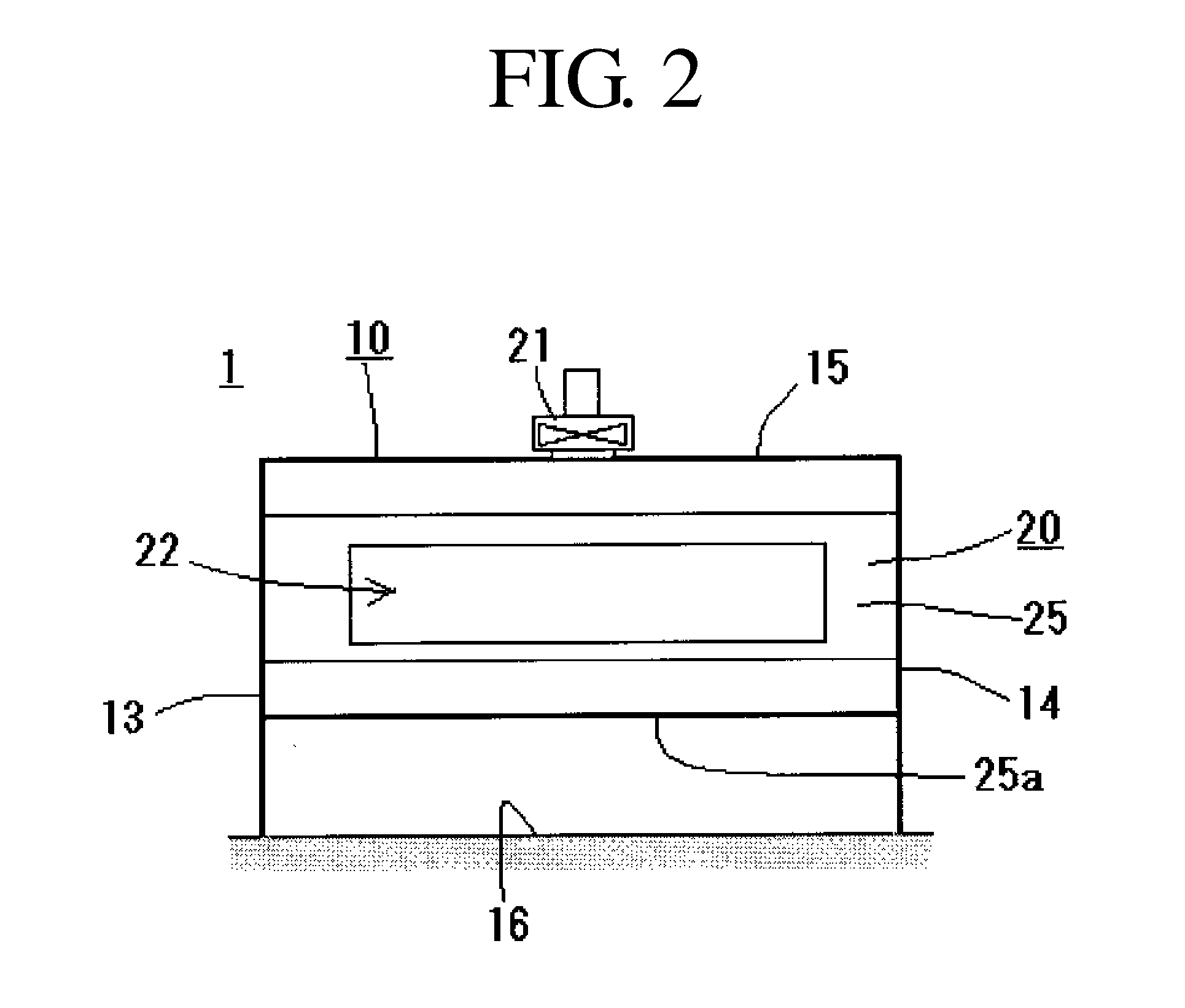Blasting Chamber
a technology of working chamber and abrasive, which is applied in the direction of lighting and heating apparatus, heating types, ventilation systems, etc., can solve the problems of large initial investment, deterioration of painting quality, and contamination of the working environment by ejecting abrasives
- Summary
- Abstract
- Description
- Claims
- Application Information
AI Technical Summary
Benefits of technology
Problems solved by technology
Method used
Image
Examples
first embodiment
Overall Configuration
[0076]Reference numeral 1 in FIGS. 1 to 3 is the blasting chamber of the present invention. As shown in FIGS. 1 and 2, although the overall shape thereof is not particularly limited, this working chamber 1 is made so that workers M can enter together with a workpiece W and conduct work, and the working chamber 1 is provided with a substantially box-shaped main unit 10 that is surrounded by side walls 11 to 14, a roof panel 15, and a floor panel 16; a dust collection unit 20 that ventilates the main unit 10 during the blasting process; and a ventilation unit 30 that ventilates the main unit 10 during painting.
Main Unit
[0077]The above-described main unit 10 that constitutes the working chamber 1 of the present invention is a box made of, for example, metal and is formed by two pairs of opposing side walls (11 and 12, and 13 and 14), the roof panel 15, and the floor panel 16. This main unit 10 is formed to have a working space 10a which the worker M can enter toget...
second embodiment
[0126]Another example configuration (Second Embodiment) of the working chamber 1 of the present invention will be described with reference to FIGS. 5 to 7.
[0127]The working chamber 1 of this embodiment, shown in FIGS. 5 to 7, is provided with a collection unit 40 configured of a collecting duct 41, a cyclone 42, and an exhaust duct 43. The working chamber 1 differs from the working chamber 1 of the first embodiment described above with reference to FIGS. 1 to 4 in that second and third opening-and-closing means 44 and 45 are provided in the ventilation duct 10b. The remaining configuration is the same as that of the working chamber 1 of the first embodiment described with reference to FIGS. 1 to 4, and therefore, a description of the common parts will be omitted.
[0128]The cyclone 42 constituting the above-described collection unit 40 generates a swirling flow therein by the airflow passing through the inside, thereby separating and collecting the abrasive to be recycled by collectin...
third embodiment
[0147]As described above, in the second embodiment described with reference to FIGS. 5 to 7, although ventilation of the working space 10a by the dust collection unit 20 through the ventilation duct 10b and collection of the abrasive through the collection unit 40 are conducted alternately, collection of the abrasive from the working space 10a may be conducted simultaneously with ventilation of the working space 10a by the above-described dust collection unit 20.
[0148]An example configuration of the working chamber 1 configured in this way is described with reference to FIGS. 8 and 9, as a third embodiment.
[0149]In the embodiment illustrated in FIGS. 8 and 9, in addition to the collecting duct 41′, the cyclone 42′, and the exhaust duct 43′, the collection unit 40′ is provided with a dust collector 50 equipped with an air-exhaust ventilator 51, and the exhaust duct 43′ communicates with the intake opening of this dust collector 50.
[0150]By laying a perforated plate 61, such as a grat...
PUM
 Login to View More
Login to View More Abstract
Description
Claims
Application Information
 Login to View More
Login to View More - R&D
- Intellectual Property
- Life Sciences
- Materials
- Tech Scout
- Unparalleled Data Quality
- Higher Quality Content
- 60% Fewer Hallucinations
Browse by: Latest US Patents, China's latest patents, Technical Efficacy Thesaurus, Application Domain, Technology Topic, Popular Technical Reports.
© 2025 PatSnap. All rights reserved.Legal|Privacy policy|Modern Slavery Act Transparency Statement|Sitemap|About US| Contact US: help@patsnap.com



